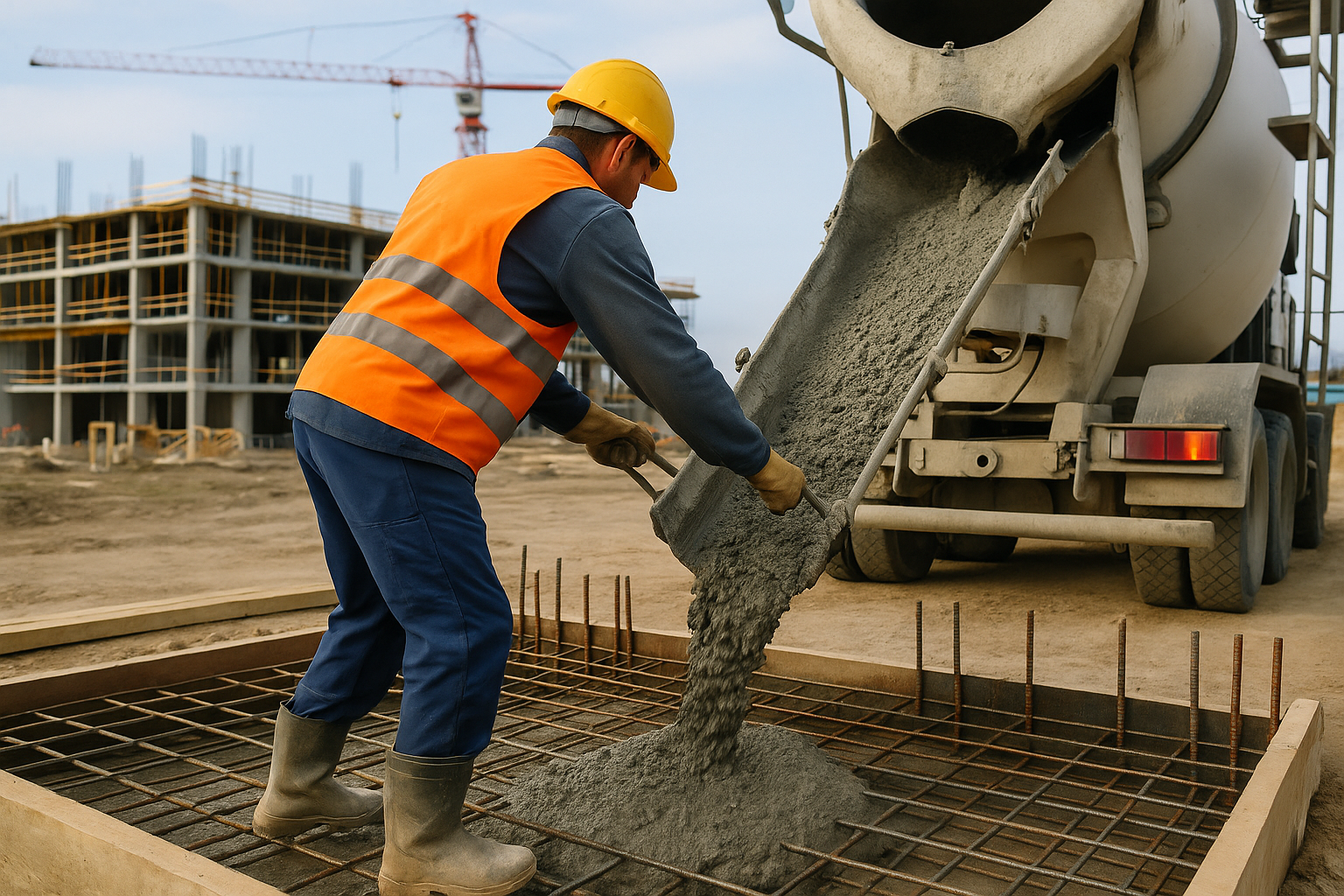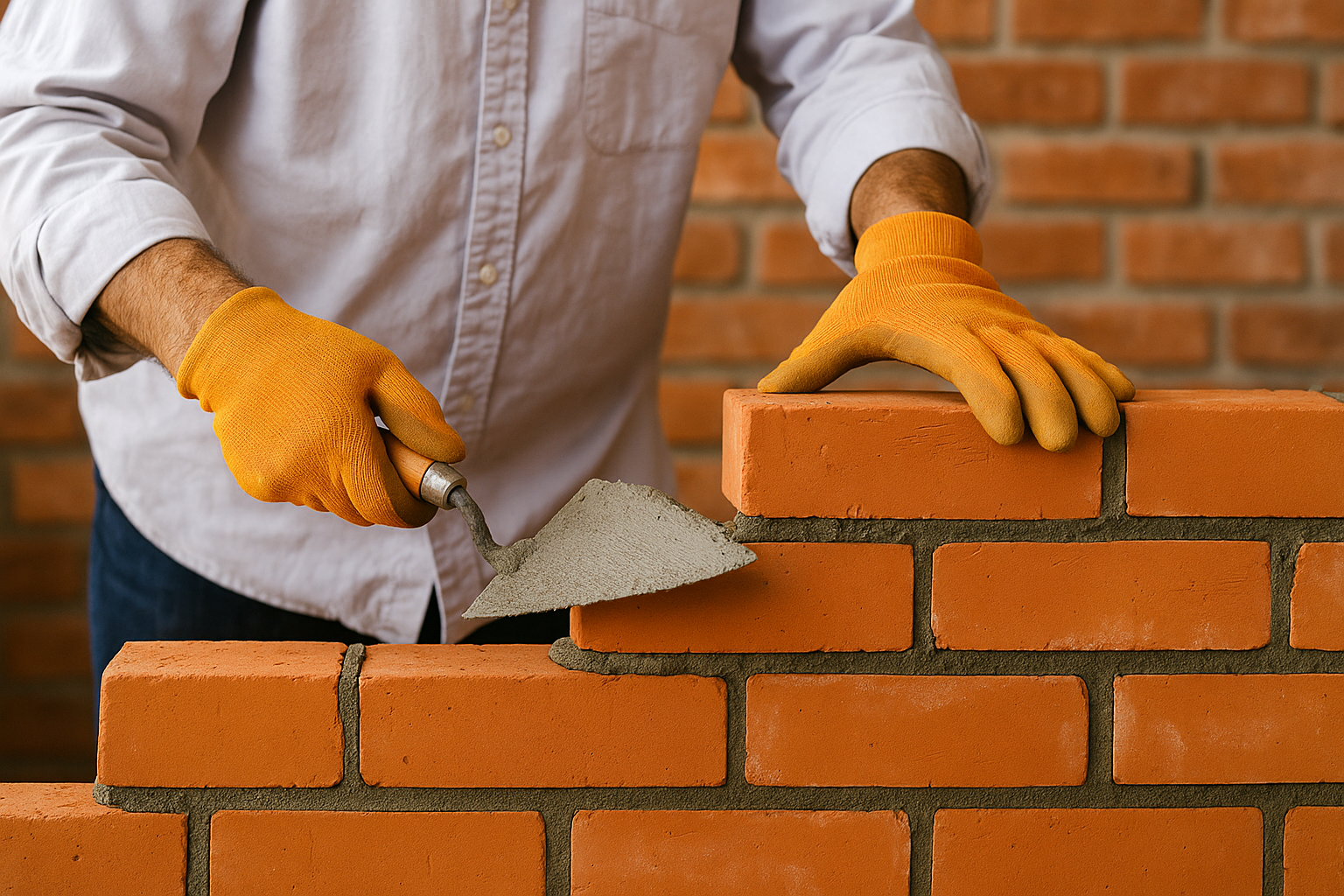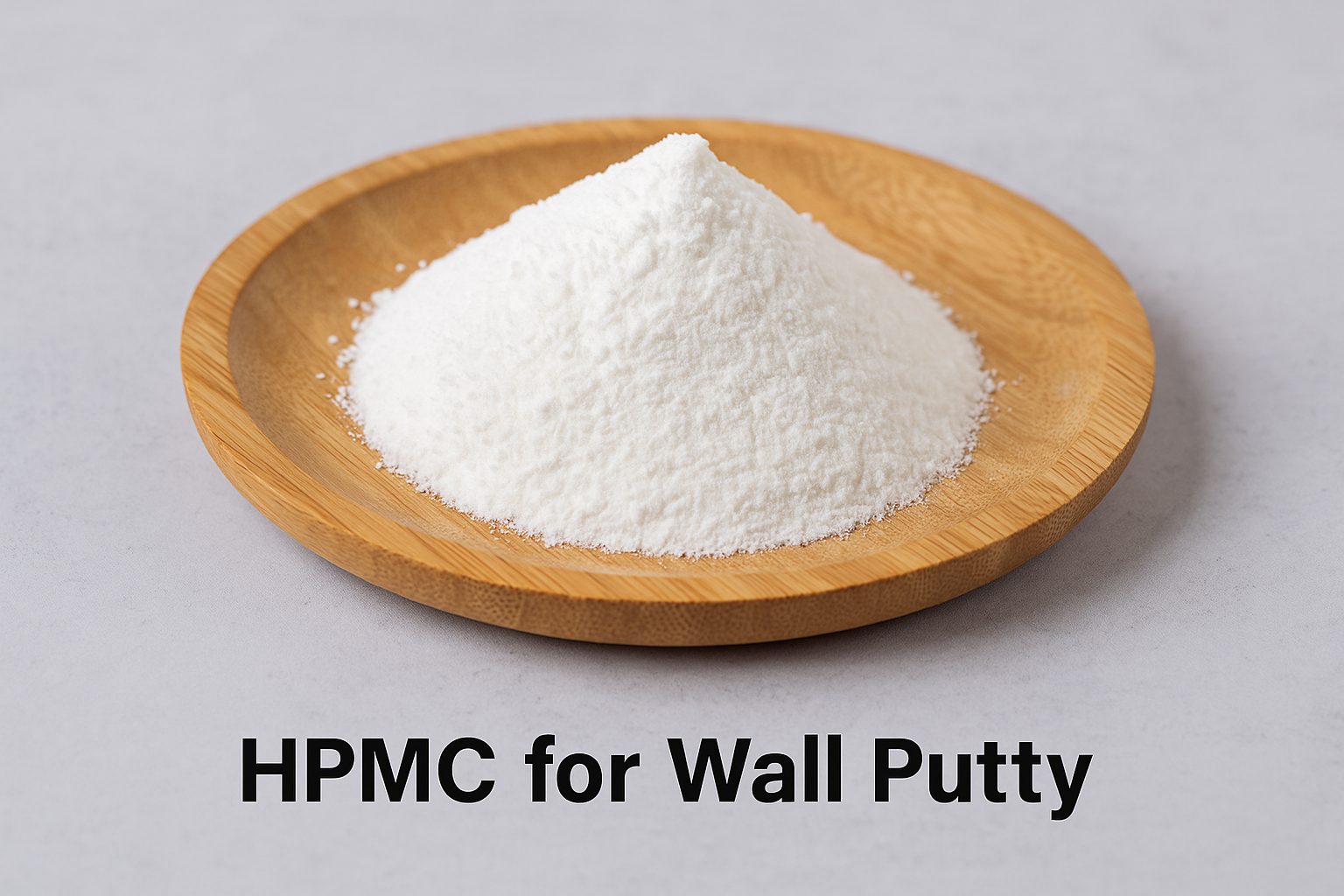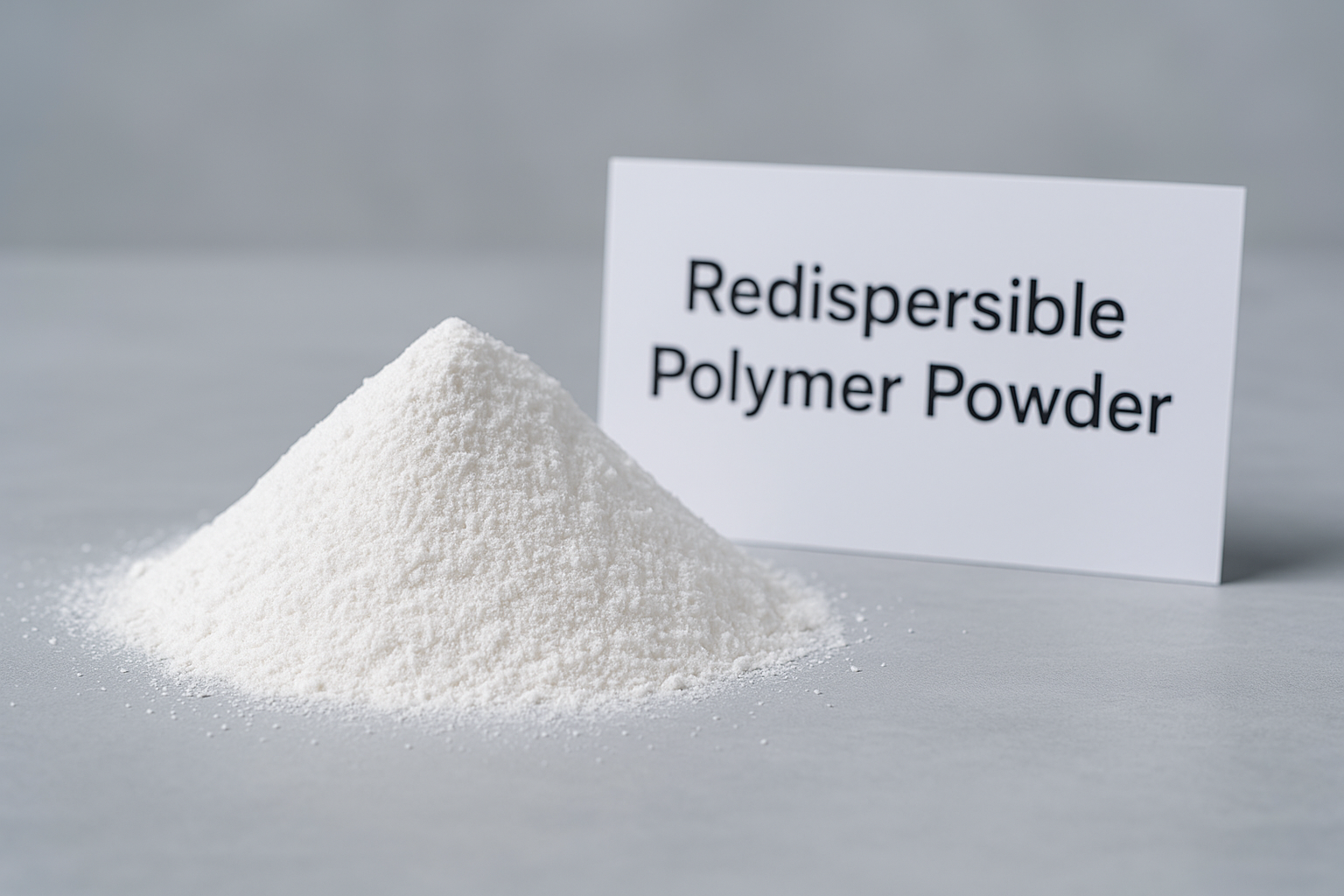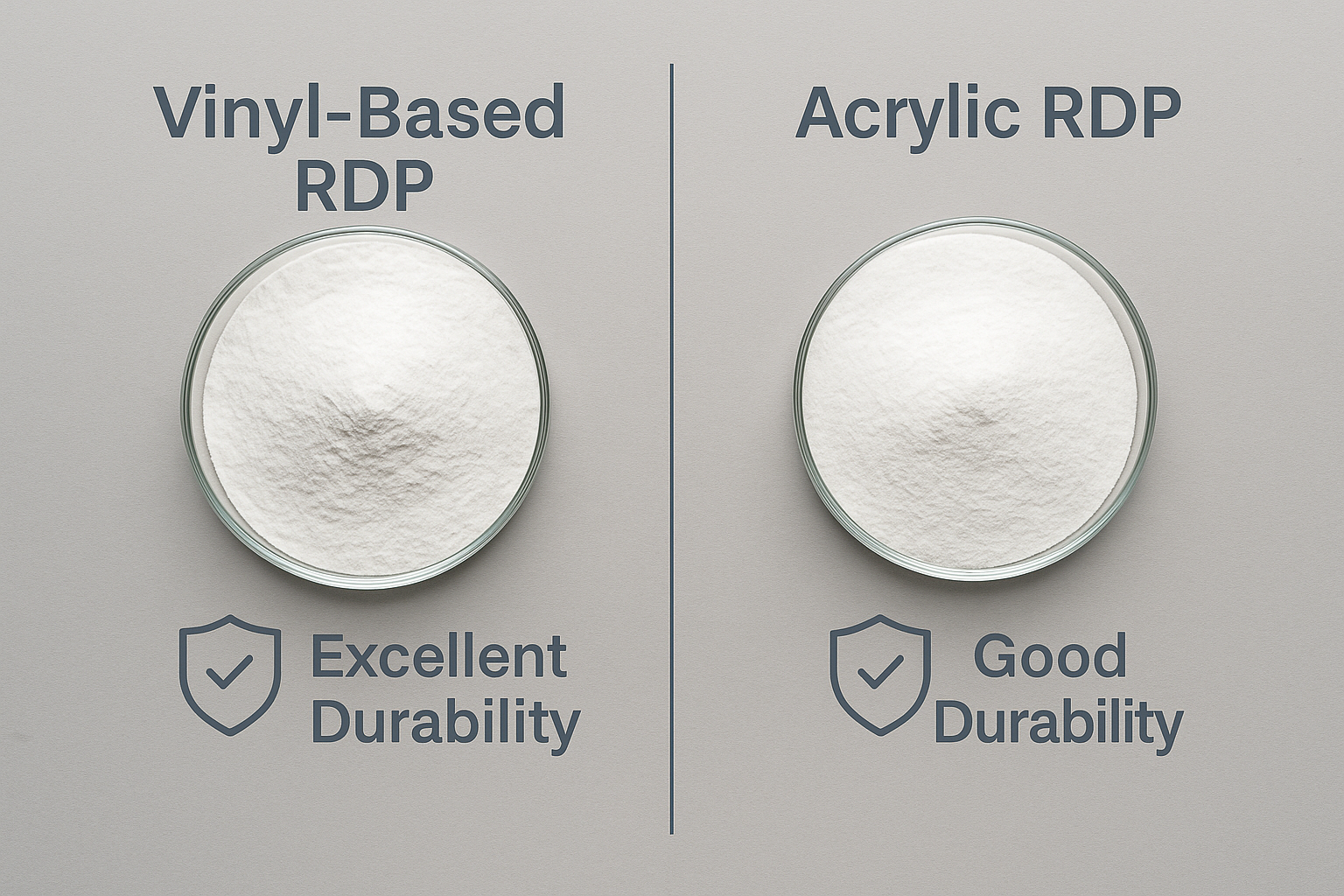I watched my crew pour a foundation last December when temperatures suddenly dropped below freezing. The concrete hadn't fully cured, and cracks appeared everywhere. This costly mistake taught me how critical temperature is for concrete curing.
Concrete can cure in cold weather, but the process slows significantly below 50°F (10°C). Below 40°F (4°C), hydration nearly stops, and freezing before reaching 500 psi compressive strength causes permanent damage. Special techniques like heated enclosures, insulating blankets, and admixtures are necessary for cold weather concreting.
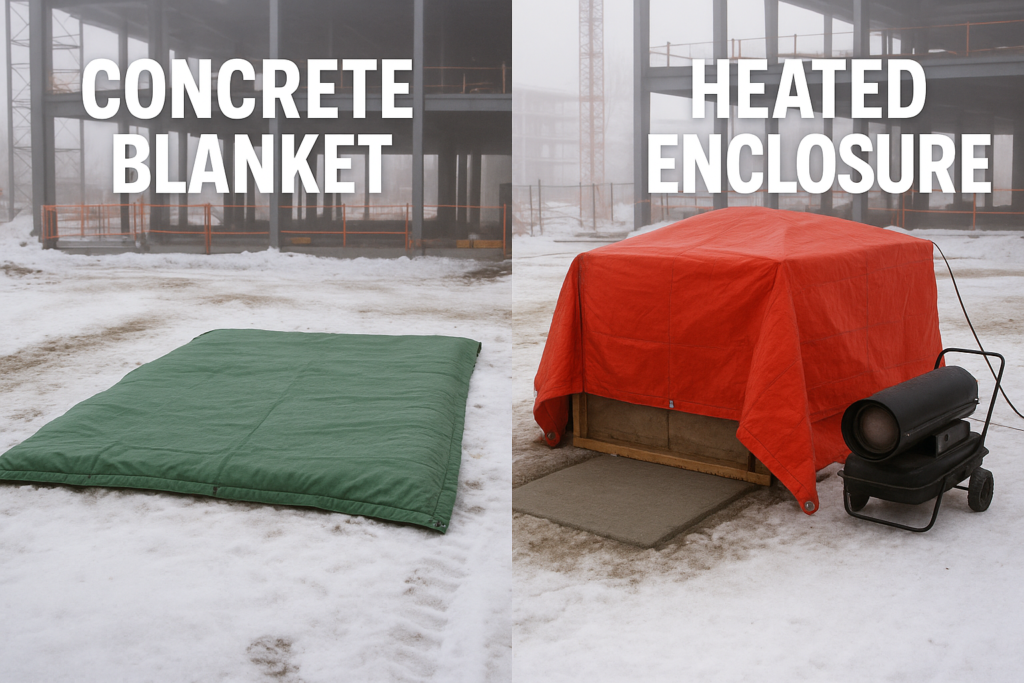
Understanding cold weather concreting1 isn't just academic—it's essential for any construction project in colder climates. I've seen projects fail and succeed based solely on how teams handled the curing process during winter months. Let's explore what happens to concrete in cold temperatures and how to ensure proper curing despite challenging conditions.
What Is The Concrete Curing Process?
I've seen many people rush concrete work, not realizing that proper curing is what makes or breaks the final strength. Rushing this critical process, especially in cold weather, leads to weak structures that fail prematurely.
Concrete curing is the process where cement hydrates and forms bonds through a chemical reaction with water. This reaction generates heat (exothermic) and typically requires temperatures above 50°F (10°C) for optimal results, with minimum moisture loss and proper time (typically 28 days for full strength development).

The curing process is more complex than many realize. When water meets cement, calcium silicate hydrate (C-S-H) forms—the "glue" that gives concrete its strength. This process has several distinct phases that are temperature-dependent:
Stages of Concrete Curing
| Stage | Time Period | What Happens | Temperature Sensitivity |
|---|---|---|---|
| Initial Set | 1-4 hours | Concrete changes from plastic to rigid state | Highly sensitive |
| Final Set | 4-8 hours | Concrete gains enough strength to support some weight | Very sensitive |
| Early Strength | 1-3 days | Reaches 30-50% of design strength | Moderately sensitive |
| Continued Hardening | 3-28 days | Gradually approaches design strength | Less sensitive |
I've tested concrete samples cured at different temperatures, and the results are striking. Samples cured at 73°F (23°C) reached their design strength on schedule, while samples at 40°F (4°C) took more than twice as long to reach the same strength. Below freezing, the samples never reached their intended strength at all, making temperature control absolutely crucial during the first few days of curing.
How Do Professional Organizations Define Cold Weather Concrete?
I once consulted on a project where the contractor ignored cold weather guidelines because daytime temperatures seemed "warm enough." The nighttime freeze damaged the new concrete beyond repair, costing thousands in repairs that proper precautions would have prevented.
Professional organizations define cold weather concreting as work performed when ambient temperatures fall below specific thresholds. The Canadian CSA A23.1 sets this at below 5°C (41°F), while ACI 306 defines it as when the air temperature has fallen to, or is expected to fall below, 40°F (4.4°C) during the protection period.
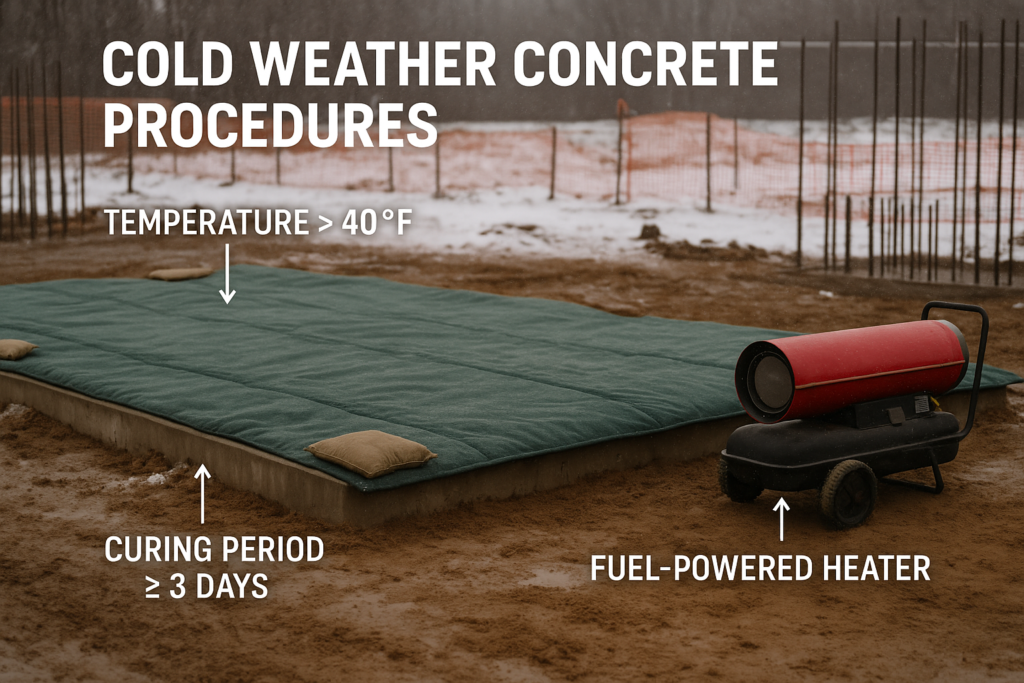
Different regions and organizations approach cold weather concreting with varying levels of caution, reflecting local conditions and experience. I find it helpful to understand these definitions in detail because they inform when special measures become necessary:
Comparison of Cold Weather Concrete Definitions
| Organization | Temperature Threshold | Protection Period | Special Requirements |
|---|---|---|---|
| ACI 306 | Below 40°F (4.4°C) | At least 48 hours | Temperature monitoring, heating materials, protective coverings |
| CSA A23.1 (Canada) | Below 5°C (41°F) | 7 days | Enclosures, heated materials, insulation |
| European Standards | Below 5°C (41°F) | 3-7 days depending on cement type | Proportional increase in protection with temperature drop |
| Russian SNIP | Below -3°C (26.6°F) | Duration based on concrete mass | Specialized admixtures for extreme cold |
While working in northern regions, I've had to follow these stringent requirements even when they seemed excessive. The projects where we maintained perfect temperature control consistently outperformed those where corners were cut. In my experience, the stricter Canadian standards produce the most reliable results, especially for structural concrete that will bear significant loads.
What Are The Methods For Curing Concrete In Cold Weather?
I remember a bridge project in Minnesota where temperatures hit -20°F. We had to use every trick in the book—heated enclosures, admixtures, and constant monitoring. The extra effort paid off when core samples showed perfect strength development despite the brutal conditions.
Cold weather concrete curing methods include heated enclosures (using hydronic heaters or portable furnaces), insulating blankets, chemical admixtures (accelerators), and using hot water and heated aggregates during mixing. These approaches maintain concrete temperature above 50°F (10°C) during the critical first 48-72 hours.
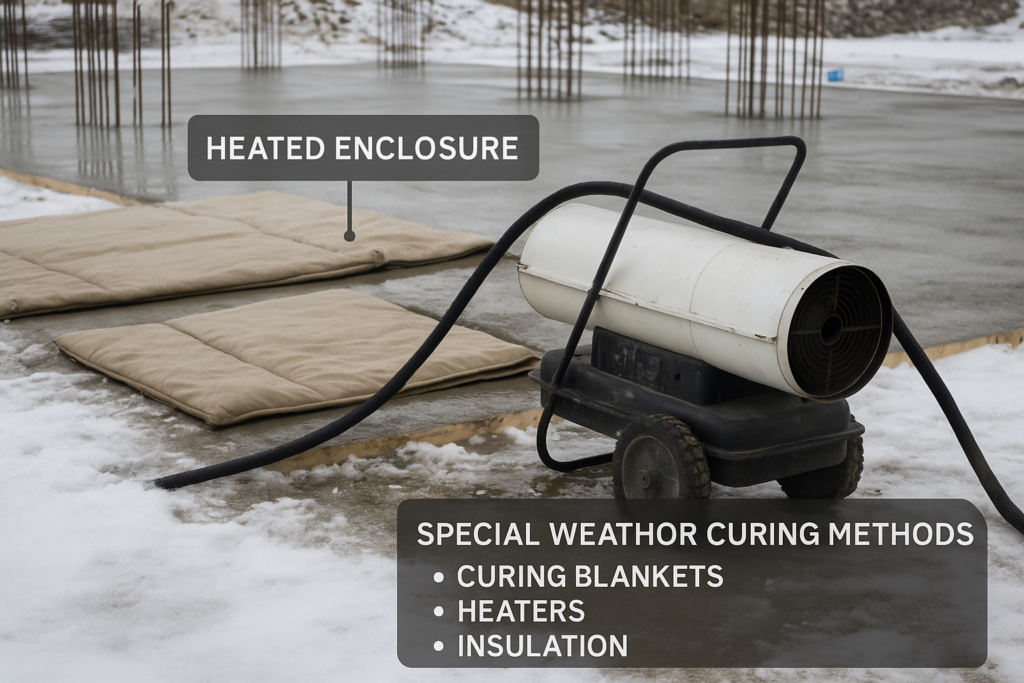
Each cold weather curing method has specific applications depending on project size, ambient conditions, and available resources. Through years of trial and error, I've developed a systematic approach to selecting the right method:
Effectiveness of Cold Weather Curing Methods
| Method | Temperature Range | Cost | Advantages | Limitations |
|---|---|---|---|---|
| Heated Enclosures | Down to -20°F (-29°C) | High | Complete temperature control; humidity management | Labor intensive; fuel costs; fire risks |
| Insulating Blankets | Down to 25°F (-4°C) | Medium | Easy to deploy; reusable | Limited temperature increase; wind can reduce effectiveness |
| Concrete Admixtures | Enhances other methods | Medium | Accelerates setting time; increases early heat | Cannot replace physical protection; may affect long-term properties |
| Heated Materials | Enhances initial concrete temperature | Medium-High | Higher starting temperature; better early strength | Requires specialized equipment; careful temperature control |
For small residential projects, I typically recommend insulating blankets combined with admixtures, which provide adequate protection at reasonable cost. For critical infrastructure like bridges or high-rise foundations, I insist on heated enclosures with redundant heating systems and 24-hour temperature monitoring. The method selection ultimately depends on the concrete's importance, ambient conditions, and budget constraints.
What Temperature And Curing Period Does Concrete Require According To Standards?
I once witnessed a contractor claim his concrete was "tough enough" after just two days in 45°F weather. When we tested cores at 28 days, the strength was barely 60% of the design requirement. Following proper curing periods isn't arbitrary—it's essential for structural integrity.
According to IS Code 270 and ACI, concrete requires minimum temperatures of 50°F (10°C) for normal curing and 40°F (4.4°C) as an absolute minimum. The required curing period varies by cement type: 7 days for ordinary Portland cement, 4-5 days for rapid hardening cement, and up to 14 days for low-heat cement.

Standards organizations establish minimum requirements based on extensive testing and real-world experience. After managing concrete projects in varying climates, I've found these requirements incorporate reasonable safety factors:
Required Concrete Protection Periods by Temperature
| Ambient Temperature | Minimum Protection Period (OPC) | Minimum Concrete Temperature | Special Requirements |
|---|---|---|---|
| Above 50°F (10°C) | 7 days | 50°F (10°C) | Standard moisture retention |
| 40-50°F (4-10°C) | 7 days | 50°F (10°C) | Insulation or heating required |
| 30-40°F (-1 to 4°C) | 10 days | 55°F (13°C) | Active heating typically required |
| Below 30°F (-1°C) | 14 days | 55°F (13°C) | Heated enclosure mandatory |
For high-performance concrete mixes or critical structural elements, I always exceed these minimums. On a dam project in Colorado, we maintained 60°F (15.5°C) for 14 days despite ambient temperatures well below freezing. The completed structure has performed flawlessly for over a decade, validating the approach. Remember that these are minimum requirements—extending protection periods improves long-term durability.
How Long Does Concrete Take To Cure In Cold Weather?
I once had a client who couldn't understand why his garage slab took weeks to reach sufficient strength for vehicle traffic during a cold December. The calendar time to reach specific strength milestones can be dramatically different based on temperature.
In cold weather (40-50°F/4-10°C), concrete takes approximately twice as long to cure compared to standard conditions (73°F/23°C). A typical mix reaching 3,000 psi in 7 days at 73°F might take 14 days at 40°F. Below 40°F, curing slows dramatically, potentially taking 30+ days to reach equivalent strength.

The extended curing time in cold weather creates scheduling challenges for construction projects. Based on laboratory testing and field experience, I've developed this reference table to help predict strength development:
Concrete Curing Time by Temperature
| Temperature | Time to 500 psi (safe from freezing) | Time to 75% Design Strength | Time to Full Design Strength |
|---|---|---|---|
| 73°F (23°C) | 1-2 days | 7 days | 28 days |
| 55°F (13°C) | 2-3 days | 9-10 days | 35-40 days |
| 40°F (4°C) | 4-5 days | 14-16 days | 45-60 days |
| 30°F (-1°C) | Requires heating | 20+ days with protection | May never reach if frozen early |
| Below 20°F (-7°C) | Requires extensive heating | Extreme protection needed | Significant strength loss likely |
During a winter high-rise project in Chicago, we developed a "strength-gained-per-day" tracking system based on the concrete's temperature history. This allowed us to accurately predict when shores could be removed and when the next floor could be poured. Despite average temperatures below freezing, we maintained our schedule by adjusting our protection measures based on daily strength calculations rather than calendar time.
What Precautions Should Be Taken In Cold Weather Concreting?
I learned about cold weather precautions the hard way when a municipal sidewalk project failed spectacularly after an unexpected freeze. The city had to remove and replace over 2,000 square feet of scaling, crumbling concrete that never properly cured.
Cold weather concreting precautions include using windbreaks and enclosures, pre-heating materials (keeping water and aggregates warm), adding approved accelerating admixtures, maintaining temperature monitoring, providing proper insulation after placement, and potentially using Type III (high-early-strength) cement.
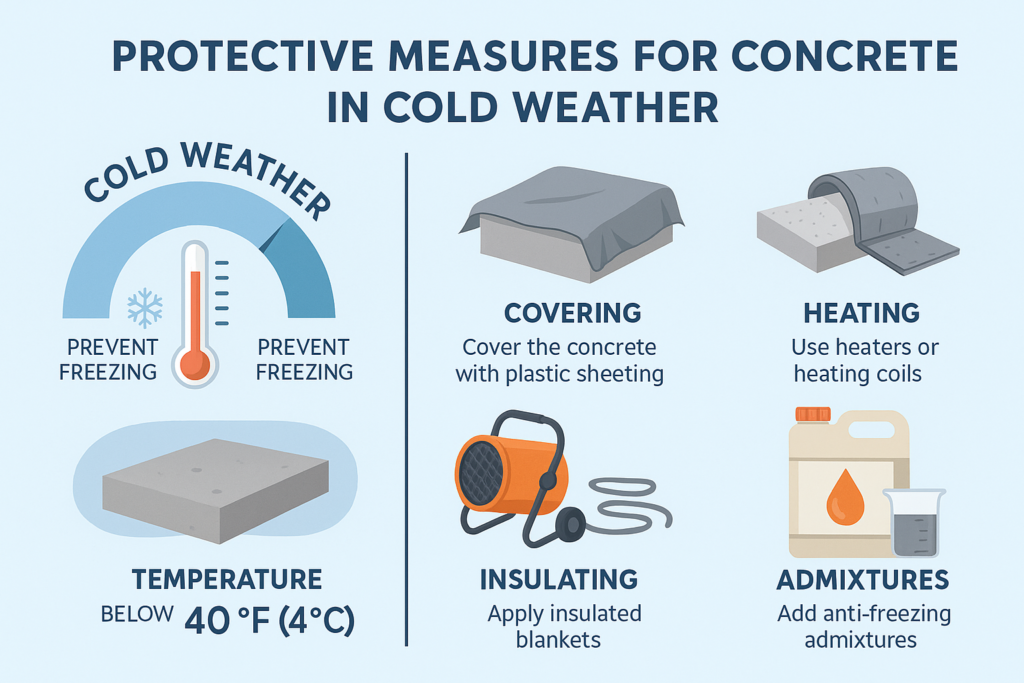
Beyond these basic precautions, successful cold weather concreting requires a comprehensive approach addressing every stage of the process:
Cold Weather Concreting Checklist
| Stage | Precautions | Monitoring Requirements | Common Failures |
|---|---|---|---|
| Pre-Placement | Heat materials; warm forms; remove ice; prepare enclosures | Material temperatures; weather forecast | Frozen subgrade; cold forms drawing heat |
| Mixing | Use hot water (up to 180°F/82°C); warm aggregates; add accelerators | Concrete temperature at plant and delivery | Inconsistent mix temperature; flash setting |
| Placement | Minimize air exposure; use windbreaks; heat adjacent structures | Ambient and concrete temperatures | Cold joints; uneven setting; surface freezing |
| Protection | Insulate immediately; maintain heat source; seal against moisture loss | Continuous temperature logging at multiple points | Heat loss at edges; uneven heating; drying from heaters |
| Curing | Maintain temperatures above minimums; gradually reduce heat | Temperature gradients; strength development | Thermal shock during cooling; inadequate strength gain |
For a high-stakes project like a hospital foundation in northern Michigan, I implemented a multi-layered protection system with redundant heating, 24-hour monitoring with SMS alerts, and emergency generators in case of power failure. The extreme caution paid off when temperatures dropped to -15°F for a week, yet our concrete maintained a steady 55°F core temperature throughout the critical curing period.
How Much Do Winter Concreting Measures Cost?
A developer once asked me to skip cold weather measures to save money on a commercial project. I showed him photos of a similar building where concrete had failed due to freezing, along with the $300,000 repair bill. The additional cold weather measures suddenly seemed like a bargain.
Winter concreting costs increase 5-25% compared to moderate weather conditions. For a typical project, heating materials adds 3-5%, temporary enclosures add 5-10%, specialized admixtures add 1-3%, and additional labor for monitoring and maintenance adds 3-7%. These costs vary by project size, location, and ambient temperatures.
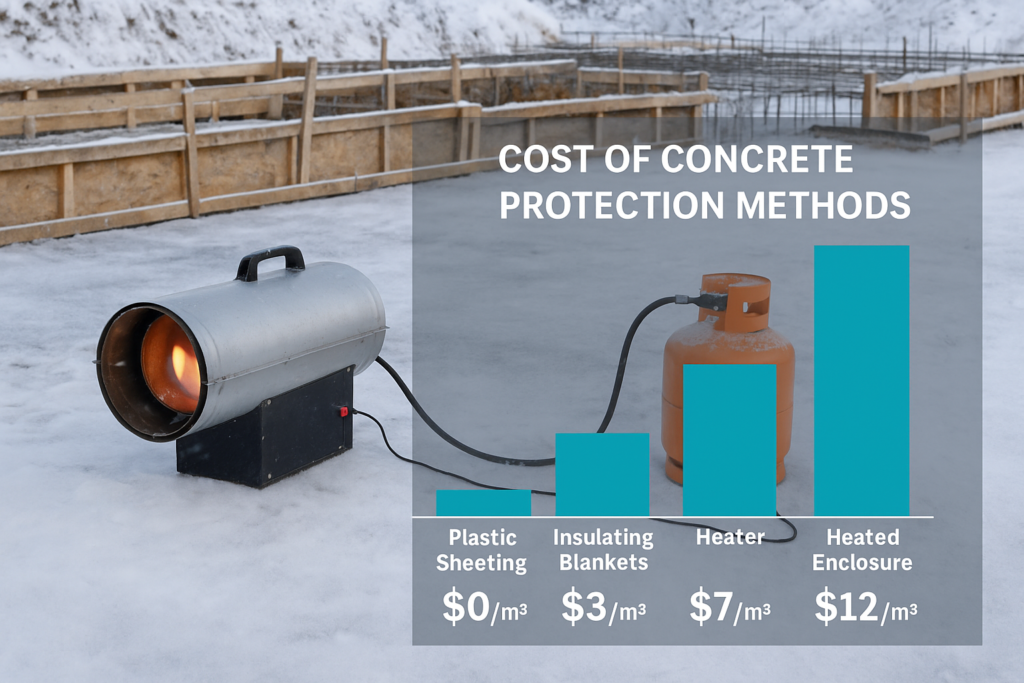
The economics of cold weather concreting need to be weighed against the risks of concrete failure or project delays. Based on dozens of winter projects I've managed, I've compiled this cost-benefit analysis:
Winter Concreting Cost-Benefit Analysis
| Protection Method | Cost Increase | Benefit | Project Size Considerations |
|---|---|---|---|
| Heated Enclosures | 8-15% | Complete temperature control; allows work in any conditions | More economical for large pours; significant setup time |
| Insulating Blankets | 3-6% | Simple, reusable; minimal setup | Effective for smaller projects; limited temperature control |
| Accelerating Admixtures | 1-3% | Speeds set time; reduces protection period | Cost-effective for all projects; may affect long-term properties |
| Heated Materials | 3-5% | Higher initial temperatures; better early strength | Requires ready-mix plant capability; more important for thin sections |
| Temperature Monitoring | 1-2% | Prevents failures; documents compliance | Critical for all winter projects regardless of size |
For a mid-rise apartment building in Boston, we conducted a detailed cost analysis that showed spending $42,000 on winter concreting measures allowed us to continue work through winter months, avoiding $275,000 in extended general conditions and financing costs that would have resulted from delaying until spring. The decision to proceed with proper cold weather measures resulted in substantial net savings despite the additional concrete costs.
How Can You Make Your Cold Weather Protection Plan Perfect?
I once reviewed a cold weather protection plan that focused exclusively on maintaining temperature without addressing moisture loss. The concrete reached temperature targets but developed severe surface crazing due to low humidity in the heated enclosure—a detail that would have been caught with a more comprehensive approach.
Create a perfect cold weather protection plan by developing detailed procedures addressing all five critical factors: temperature control, moisture retention, protection duration, gradual cooling, and detailed monitoring. Document specific responsibilities, contingency plans for extreme weather, and verification methods for compliance.
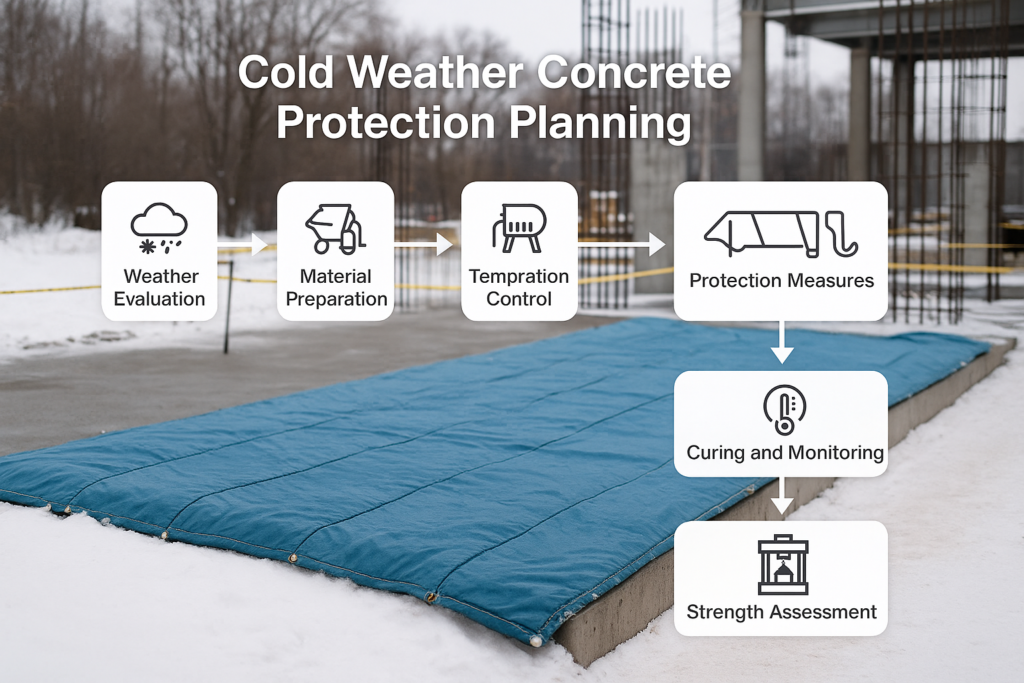
A truly effective cold weather concrete plan must be comprehensive yet practical. Drawing from my experience with both successful and failed projects, I've developed this framework:
Components of an Effective Cold Weather Concrete Plan
| Component | Essential Elements | Documentation Required | Integration with Schedule |
|---|---|---|---|
| Temperature Monitoring System | Sensor types, locations, alert thresholds | Temperature logs; calibration records | Pre-pour approvals; strength verification points |
| Heating System Design | Heat source specifications; backup systems; distribution | Equipment certifications; fuel calculations | Setup time; maintenance periods |
| Moisture Control | Humidity targets; protection methods | RH% monitoring logs | Curing compound application timing |
| Materials Adjustments | Mix design modifications; admixture dosages | Supplier certifications; testing results | Material delivery coordination |
| Personnel Training | Responsibilities; emergency procedures | Training records; competency verification | Staffing plans for 24-hour monitoring |
| Contingency Plans | Weather thresholds for additional measures; equipment failures | Decision tree documentation | Trigger points integrated with schedule |
| Quality Verification | Testing protocols; acceptance criteria | Test results; non-compliance reports | Hold points for verification before proceeding |
When managing an airport runway extension project that couldn't afford delays, I implemented a three-tier protection plan that automatically increased protection measures as temperatures decreased. This included transitioning from insulating blankets to partial enclosures to fully heated structures based on forecasted temperatures. We established clear decision points, assigned specific responsibilities, and conducted daily briefings. The result was continuous progress through a particularly harsh winter with zero concrete defects.
Conclusion
Cold weather significantly slows concrete curing and requires special measures to prevent damage. Using heated materials, proper insulation, and maintaining temperatures above 40°F (4°C) for the full protection period will ensure your concrete achieves its designed strength even in winter conditions.
-
Explore essential techniques and guidelines to ensure successful concrete curing in cold temperatures. ↩

